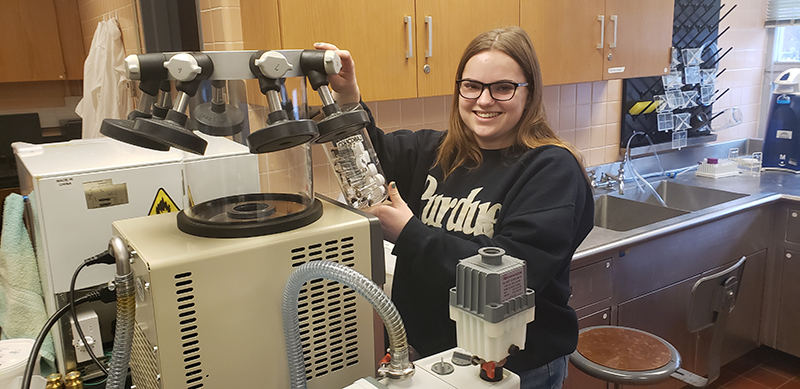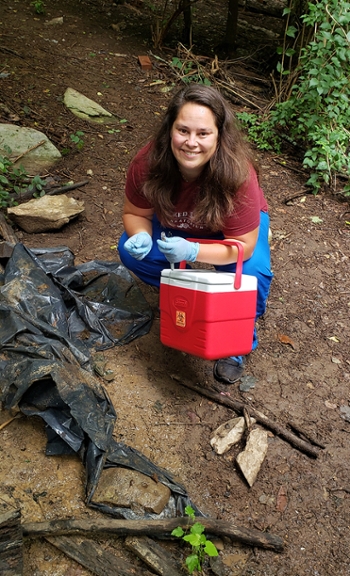What bones can tell us
Forensic anthropology course offers real-world perspectives on crime-scene investigations

From identifying dead bodies in East Africa to analyzing crime scenes like the forensic anthropologist featured in the TV show "Bones," Melanie Beasley brings many unique experiences into the classroom.
The assistant professor of anthropology specializes in stable isotopes, which can help identify unknown human remains and determine time of death, among other uses. This unique skillset has taken her to California, Italy, Jordan, and Africa, where she analyzed samples that dated back as many as 4 million years.
In a recent humanitarian project, Beasley traveled to East Africa to analyze human remains. She utilized forensic anthropology skills to help identify the deceased individuals, many of whom are found without identification. This process helps authorities then engage with families to inform them of their missing relative’s whereabouts.
 Beasley (pictured) is fascinated by the idea that a scientist can establish a historical record by analyzing tissues and comparing them to the surrounding environment. She shares this fascination with the students she teaches in the brand-new Introduction to Forensic Anthropology course that launched this spring.
Beasley (pictured) is fascinated by the idea that a scientist can establish a historical record by analyzing tissues and comparing them to the surrounding environment. She shares this fascination with the students she teaches in the brand-new Introduction to Forensic Anthropology course that launched this spring.
“It’s a broad look at what an individual who’s doing forensic anthropology casework would be involved in,” Beasley said. “Anything from thinking about the role of a forensic anthropologist in the medicolegal system in the United States to how you would go about assisting law enforcement with the actual excavation and analysis of remains.”
Still in its infancy, this class provides students with a real-world perspective on crime-scene investigation and even gives them opportunities to touch and feel samples of what a professional forensic anthropologist might study.
“My favorite part of the class is the hands-on activities our professor has us do,” said Peyton James, a freshman majoring in anthropology. “So far this semester, our professor has brought some animal bones to show us, physically, the varying density and shape of different bones. This is an extremely beneficial experience to gain at the undergrad level.”
The in-depth nature of the field does not mean that students in Beasley’s class have to be well-versed in advanced research methods, however.
“Even if students felt like they weren’t strong in science, that’s OK,” Beasley said. “You don’t need a background in anthropology or science to be able to take the class.”
Since it is an introductory course, Beasley developed the curriculum to include activities that provide an accurate depiction of what someone in the field might encounter. As they progress in their coursework, students should be able to evaluate the accuracy of crime shows like "Bones," whose lead character, Dr. Temperance Brennan, was a forensic anthropologist.
Beasley utilizes multiple anthropological disciplines, including paleontology, bioarchaeology, and forensics. She exposes students to all three when teaching about the principles of skeletal biology and archaeology for human identification, hoping that they come to appreciate the important role that anthropologists play.
“I hope that through forensic anthropology, it highlights the unique space that anthropology occupies between the natural and social sciences, and you can learn that wonderful complexity of how to talk about diverse topics … and how we approach topics like sex and race in forensic investigation,” Beasley said.
Max Howard, a senior in anthropology, said the cross-disciplinary approach was actually what attracted him to the course.
“I am interested in forensics and anthropology, and the intersection of the two is something I want to pursue as a career,” Howard said. “This class was a great opportunity, and I think anyone that’s interested in either forensics or anthropology would be interested in it.”
Likewise, James wanted to develop skills for both forensic anthropology and other real-world situations.
“I hope to build a strong foundation in my forensic skills and work on my ability to analyze a situation, which in this case is a crime scene,” James said.
Whether Beasley’s students wanted to understand the truths and myths behind TV crime shows or to gain real-world skills that would enable them to work in the field, they had the opportunity to do both this spring. And they learned from an expert whose work as a forensic anthropologist has taken her all over the globe.
“She has so much experience in the field, and it really helps with looking at cases,” said Em Clemenz, a sophomore in classical studies and law and society. “She is able to put the class in perspective and give students an accurate look at the field. It’s easily my favorite class this semester with a great professor, interesting homework assignments, and colorful stories.”